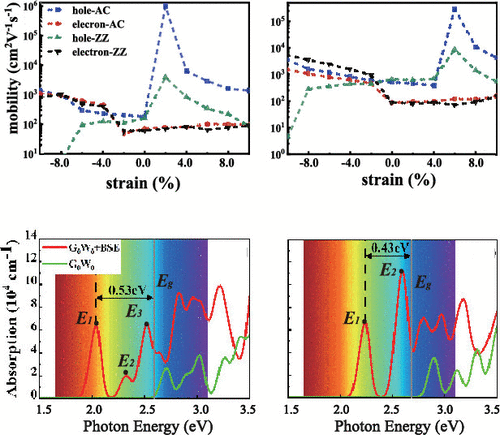当前位置:
X-MOL 学术
›
J. Phys. Chem. Lett.
›
论文详情
Our official English website, www.x-mol.net, welcomes your feedback! (Note: you will need to create a separate account there.)
Room Temperature Bound Excitons and Strain-Tunable Carrier Mobilities in Janus Monolayer Transition-Metal Dichalcogenides
The Journal of Physical Chemistry Letters ( IF 5.7 ) Pub Date : 2020-03-27 , DOI: 10.1021/acs.jpclett.0c00520 Bowen Hou 1 , Yiming Zhang 1 , Hao Zhang 1 , Hezhu Shao 2 , Congcong Ma 3 , Xintong Zhang 1 , Ying Chen 3 , Ke Xu 1 , Gang Ni 1 , Heyuan Zhu 1
The Journal of Physical Chemistry Letters ( IF 5.7 ) Pub Date : 2020-03-27 , DOI: 10.1021/acs.jpclett.0c00520 Bowen Hou 1 , Yiming Zhang 1 , Hao Zhang 1 , Hezhu Shao 2 , Congcong Ma 3 , Xintong Zhang 1 , Ying Chen 3 , Ke Xu 1 , Gang Ni 1 , Heyuan Zhu 1
Affiliation

|
The successful synthesis of Janus transition metal dichalcogenides offers new opportunities in two-dimensional materials due to its novel properties induced by structural mirror asymmetry. Herein, by using the first-principle calculations, the thermodynamical stability for monolayers MoSSe and WSSe is demonstrated by phonon dispersion with no imaginary frequencies. No longitudinal optical–transverse optical (LO–TO) splitting exists at the Γ point and phonon frequencies are red-shifted, since the 2D Coulomb screening effect is introduced to eliminate the spurious interaction between adjacent layers. An indirect–direct–indirect transition in band gaps for both MoSSe and WSSe is observed, and tunable mobilities can be realized by uniaxial strain, reaching up to 106 cm2 V–1 s–1 when applying 2% tensile strain along the zigzag direction to monolayer MoSSe, which provides a good platform for flexible electronic devices. Large band gaps of 2.569 and 2.666 eV are predicted for monolayers MoSSe and WSSe when considering many-body quasiparticle corrections. The enhanced electron–hole interaction caused by a weak screening effect leads to considerable binding energies for both MoSSe and WSSe, and such tightly binding excitons with large oscillator strengths generate strong absorption peaks in visible region. The remarkable properties of Janus monolayers MoSSe and WSSe make them promising in next-generation microelectronic, optoelectronic, and valleytronic devices.
中文翻译:

Janus单层过渡金属二硫属元素化物中的室温约束激子和可调节的载流子迁移率。
Janus过渡金属二卤化物的成功合成为二维材料提供了新的机会,这是由于其结构镜不对称性引起的新颖性质。在此,通过使用第一性原理计算,单层MoSSe和WSSe的热力学稳定性通过没有虚数频率的声子扩散来证明。由于引入了二维库仑屏蔽效应以消除相邻层之间的虚假相互作用,因此在Γ点处不存在纵向光学-横向光学(LO-TO)分裂,并且声子频率发生红移。观察到MoSSe和WSSe的带隙之间存在着间接-直接-间接的过渡,并且通过单轴应变可以实现可调迁移率,达到10 6 cm 2 V –1s –1沿锯齿形方向向单层MoSSe施加2%的拉伸应变时,这为柔性电子设备提供了良好的平台。当考虑多体准粒子校正时,预测单层MoSSe和WSSe的大带隙为2.569和2.666 eV。弱屏蔽效应导致增强的电子-空穴相互作用导致MoSSe和WSSe都具有相当大的结合能,而这种具有大振荡器强度的紧密结合的激子会在可见光区域产生强吸收峰。Janus单层MoSSe和WSSe的卓越性能使其在下一代微电子,光电和Valleytronic器件中很有前途。
更新日期:2020-04-24
中文翻译:

Janus单层过渡金属二硫属元素化物中的室温约束激子和可调节的载流子迁移率。
Janus过渡金属二卤化物的成功合成为二维材料提供了新的机会,这是由于其结构镜不对称性引起的新颖性质。在此,通过使用第一性原理计算,单层MoSSe和WSSe的热力学稳定性通过没有虚数频率的声子扩散来证明。由于引入了二维库仑屏蔽效应以消除相邻层之间的虚假相互作用,因此在Γ点处不存在纵向光学-横向光学(LO-TO)分裂,并且声子频率发生红移。观察到MoSSe和WSSe的带隙之间存在着间接-直接-间接的过渡,并且通过单轴应变可以实现可调迁移率,达到10 6 cm 2 V –1s –1沿锯齿形方向向单层MoSSe施加2%的拉伸应变时,这为柔性电子设备提供了良好的平台。当考虑多体准粒子校正时,预测单层MoSSe和WSSe的大带隙为2.569和2.666 eV。弱屏蔽效应导致增强的电子-空穴相互作用导致MoSSe和WSSe都具有相当大的结合能,而这种具有大振荡器强度的紧密结合的激子会在可见光区域产生强吸收峰。Janus单层MoSSe和WSSe的卓越性能使其在下一代微电子,光电和Valleytronic器件中很有前途。



























 京公网安备 11010802027423号
京公网安备 11010802027423号